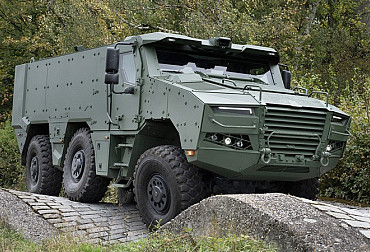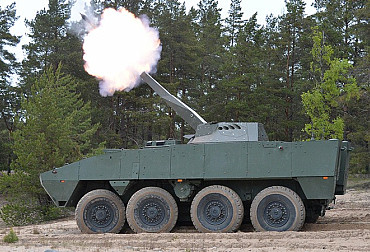The Heron 1 universal drone systems are continuously upgraded. The Army of the Czech Republic knows what it wants and knows what it gets
On August 8 this year, the Ministry of Defense announced the decision to start negotiations with the Israeli government on the acquisition of three Heron 1 drones, including all accessories. This type came out as the best of the options under consideration. According to the Army of the Czech Republic, it meets the requirements that the army places on such a system, both on the territory of the Czech Republic and for possible foreign deployment. The Heron 1 has been operational in Israel since 2005, and is part of a "family" of successful drones consisting of the smallest type called Tactical Heron, the middle Heron 1 and the heaviest, which bears the designation Heron TP, respectively Eitan. How are they different from each other?
 Picture: On August 8 this year, the Ministry of Defense announced the decision to start negotiations with the Israeli government on the acquisition of three Heron 1 drones, including all accessories. (illustration photo) | Corporal Aaron Curran, Australian Department of Defence
Picture: On August 8 this year, the Ministry of Defense announced the decision to start negotiations with the Israeli government on the acquisition of three Heron 1 drones, including all accessories. (illustration photo) | Corporal Aaron Curran, Australian Department of Defence
The new drones are designed for the 533rd Unmanned Systems Battalion. According to the requirements of the army, they should have technologies for target recognition, SIGINT (SIGnals INTelligence) capabilities, i.e. obtaining intelligence information from radar traffic, data communication, the Internet, enemy phone calls, etc.), SAR (Synthetic Aperture Radar) technology, which is a form of radar that is used to create visual two-dimensional radar imagery), and also have the possibility of integrating weapon systems. In particular, much has been said about the last ability in the media after the announced decision, including doubts about whether Heron 1 really possesses such an ability. Completely unnecessary; the military has repeatedly confirmed that this is the case.
In order to avoid various speculations, we asked the Public Communications Department of the General Staff of the Czech Armed Forces and the Press Department of the Ministry of Defence of the Czech Republic whether the competent units of the Czech Armed Forces and the Ministry of Defence were informed by the manufacturer that the HERON system (or HERON 1) can be operationally deployed as a weapon platform with precision missiles against ground targets. The statement of Lieutenant Colonel Vlastimila Cyprisová from the General Staff was as follows: "The Army requires a multi-purpose unmanned system. According to the information from the supplier, the HERON-type vehicle or its modification meets all the criteria, including the configuration of sensors and weapon systems required by the Army. The specific conditions and technical parameters will be the result of negotiations between the MoD and the Israeli side, which are still ongoing. After that, a final decision will be made on the acquisition of the required system." We then received the following reply from the Ministry of Defence: "The initiation of negotiations with the Israeli Government for the acquisition of three HERON 1 drones is based on the precise technical specification of the Czech Army, which has evaluated this drone as optimal for its needs. The aim of the Ministry of Defence is to procure for the Army the equipment that it considers best for the performance of the tasks entrusted to it."
The Heron 1 is a medium-sized drone designed to perform both strategic and tactical missions. The English name for its class is Medium-altitude long-endurance (MALE), i.e. a medium-altitude drone with great endurance. The mean altitude here is a flight level of about 30,000 feet (approximately 9100 meters), various types of this category then reach endurance of more than 24 hours depending on the conditions, the nature of the mission and the equipment and armament carried. In terms of endurance, the Heron 1 boasts the ability to fly continuously for up to 36 hours, which is more than double the requirement of the Army of the Czech Republic, and can move at an altitude of up to 10700 m. Its range under direct control is almost 350 km (with satellite more than 1000 km), and it can move at a maximum speed of up to 260 km/h.
A quick comparison with the most popular drone of recent months, the Turkish Bayraktar TB2, reveals that the Heron 1 is twice as heavy (TB2 has a maximum take-off weight of 700 kg), can carry more than twice as much equipment and armament (the payload of TB2 does not exceed 150 kg), the Heron 1 is faster (TB2 reaches a maximum of 220 km/h), can operate at higher altitudes (TB2 operates at an altitude of 7300 m) and has a range of over 300 km under direct control.
Heron 1 is designed and constantly modernized by its manufacturer, Israel Aerospace Industries, in order to maintain and strengthen the ability to perform a very wide range of tasks, and even in this respect they exceed the above-described basic requirements of the Army of the Czech Republic for the new system: they are able to perform surveillance, observation and reconnaissance missions, in any weather, to obtain SIGINT data, incl. ELINT (ELectronic INTelligence, electronic reporting), COMINT (COMunications INTelligence, communication intelligence), and allows target targeting. Thanks to optoelectronic systems and SAR radar, it can map the terrain (day and night). It can perform tasks simultaneously and can also operate in fully automated operation.
The objection to the Heron 1, which speaks of being obsolete today, having been deployed since 2005, is of a similar nature to the objection to the tracked BVP CV90 – in both cases they are continuously modernized systems, which the army, while aware of its tasks, has chosen as a suitable or, in the case of the Heron 1, even the most suitable solution. The Heron 1 drones that will be delivered to the Army of the Czech Republic have an improved engine compared to the original type, newer reconnaissance systems, more modern radar, and in addition, the Heron 1 is also a weapon platform – although in this respect the Israeli side simply does not disclose details. Purely from the technical parameters of the drone, it is clear that it can carry more weapons than bayraktar, including the integration of the relevant control, targeting and other systems.
Heron 1, as has been said, is part of a three-member UAV family. All three share the same concept of a central load-bearing nacelle with a payload and two fuselages, nacelles that contain the wheels and wings that contain the fuel tanks – a concept that has also been adopted by the Bayraktar drones. Similarly, Tactical Heron (T-Heron), Heron 1 and Heron TP (Eitan) share a number of design features and electronic equipment. It cannot be said that the younger Heron TP is in principle a "modernized variant" of the original Heron 1; it is a continuation of the development of the capabilities of the whole family, a drone of a different category and a different purpose. To compare all three types, let's summarize their basic tactical-technical data in a table:

Picture: Basic tactical-technical data of T-Heron, Heron 1 a Heron TP





















